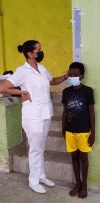Use of a "tablet pole" for the administration of ivermectin for strongyloidiasis in a field study in Ecuador
- PMID: 36709311
- PMCID: PMC9883947
- DOI: 10.1186/s40249-023-01054-7
Use of a "tablet pole" for the administration of ivermectin for strongyloidiasis in a field study in Ecuador
Abstract
Background: Establishment of efficient control programs for strongyloidiasis, the infection by Strongyloides stercoralis, is among the World Health Organization (WHO) targets for 2030. Ivermectin is a drug of choice for strongyloidiasis, but its weight-based administration can be unfeasible in remote areas. We evaluated a WHO tablet pole for administration of ivermectin in school-age children living in remote villages in Ecuador.
Methods: Children were enrolled in 16 villages in Esmeraldas Province of Ecuador, between July 2021 and June 2022. The pole identified four height intervals corresponding to ivermectin doses going from one to four tablets. For each child, we calculated the dose (µg/kg) administered with both weight-based and pole-based administration. Results were classified as follows: optimal dose, acceptable, overdose, underdose. Agreement between the two methods for estimating the number of tablets was assessed with Cohen's kappa coefficient. Estimations were reported with 95% confidence intervals (CIs).
Results: Total of 778 children (47.3% female) were enrolled, with median age of 9.59 years (interquartile range: 7.42‒11.22). Optimal dose was achieved for a higher proportion of children when assessed with weight (37.9%) than with pole (25.7%). Underdose and overdose were more frequent with the pole (8.3% and 19.2% children, respectively) than with the weight-based (3.7% and 6.0%, respectively) administration. Agreement between weight-based and pole-based administration was moderate: 0.56 (95% CI 0.51, 0.61). The two methods indicated the same number of tablets in 71.6% (95% CI 0.684, 0.748) cases.
Conclusions: In our setting, the tablet pole could be a valid alternative. The tool needs further evaluation in different populations.
Keywords: Ecuador; Ivermectin; Preventive chemotherapy; Strongyloides stercoralis; Strongyloidiasis; Tablet pole.
© 2023. The Author(s).
Conflict of interest statement
The authors declare that they have no competing interests.
Figures
References
-
- World Health Organizaiton . Ending the neglect to attain the sustainable development goals: a road map for neglected tropical diseases 2021–2030. Geneva: WHO; 2020.
-
- World Health Organization. Prequalification of medical products. https://extranet.who.int/pqweb/medicines. Accessed Sept 29 2022.
MeSH terms
Substances
Grants and funding
LinkOut - more resources
Full Text Sources



